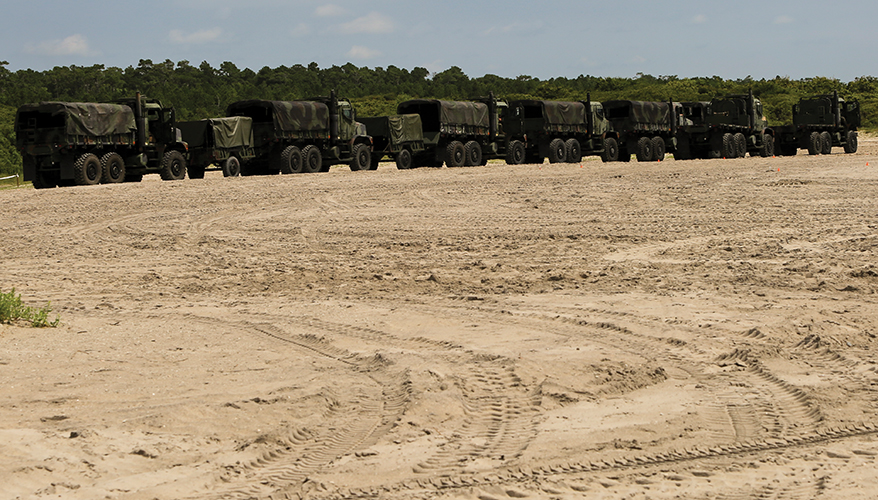Allies Need to Take Part in Services' JADC2 Goals

iStock illustration
Adm. Christopher Grady in April highlighted the three axes he integrates in his job to be successful as the vice chairman of the Joint Chiefs of Staff.
He visualizes integration “from the Pentagon down to where our servicemembers operate” as the ‘y-axis.’ He defines integration across the ‘x-axis’ as covering all domains — cyber, space, air, land, surface and subsurface.
Finally, he emphasizes the ‘z-axis’ is to “integrate across all of our partners.”
Like Grady, the U.S. military is most effective when it integrates its military planning and operations across all three axes. This is the underlying truth driving the need for joint all-domain command and control, also known as JADC2.
In its current conceptual phase, JADC2 aims to unite sensor information across the services in a cloud-like architecture, transmitting combined military service data within a geographic combatant command — the y-axis — out across all operational domains and functional commands with global missions — the x-axis. Achieving this vision will enable greater visibility of the battlefield and logistics lines across all domains and shorten the time needed for informed command decisions.
Until now, however, discussions about JADC2 often stopped with these two axes. However, the optimal approach is not limited to the U.S. Joint Force. America’s allies must be included in the conversation to fully implement a JADC2 solution that enables the United States to operate in multiple theaters and across operational domains with peak effectiveness. Incorporating allies into the framework is an essential step to incorporating the missing z-axis.
But there is significant work in front of us to realizing a Combined JADC2, or CJADC2. To date, the individual military services have focused on developing their own concepts. One industry partner identified these separate approaches as forming an environment of “limited commonality or interoperability across the defense enterprise.”
To be effective in the future, the military services will need to integrate their separate approaches to JADC2 under a common data fabric with common data formatting and rule sets to properly develop and implement a two-axis JADC2, let alone a three-axis CJADC2.
One of the challenges is the Defense Department needs to identify a joint operational lead to ensure the concept’s ongoing developmental success. A combatant command is the proper joint pathfinder for JADC2 development and implementation. As the nation looks to counter increasing aggression from the People’s Republic of China, U.S. Indo-Pacific Command is a logical choice.
Congress seems to agree. The 2023 National Defense Authorization Act specifically highlights INDOPACOM as the first recipient for any JADC2 development and implementation plans among the combatant commands. This builds off the 2022 National Security Strategy and National Defense Strategy documents, which center on the Indo-Pacific as a critically important region and identify the need for the United States to “act in common purpose” with our allies to build a “robust deterrence” against great-power threats. In other words, future command-and-control architecture needs to be built with the ability to integrate allies from the beginning.
With the current challenges, it is reasonable to ask why we would want to grow the tent now to include allies when the U.S. military’s internal house is not yet in order. The answer is straightforward. JADC2 interoperability is more than shared capability and the creation of a networked system. It also includes addressing ongoing operability, training, intellectual property rights, proprietary systems and data challenges. Problems surrounding these aspects will be magnified if allies are brought into the network as an afterthought, and thus it is imperative that we include them early in development and implementation.
Specifically, a CJADC2 architecture cannot work if allied units, platforms and weapons do not have the ability to connect to a common data fabric with U.S. platforms and systems. Integrating allies to the framework that is intentionally designed for combined interoperability will be quicker, more effective, less expensive and more enduring than attempting to incorporate incompatible systems into an inflexible architecture.
Additionally, planning for CJADC2 now necessitates the U.S. government proactively preparing for how to share classified sensor data transmitted within the network at levels that can be shared with allies.
Cyber Command’s Persistent Cyber Training Environment stands out as a laudable win for the development and implementation of CJADC2. Within the Joint Cyber Warfighting Architecture, it acts as a virtual training range that enables joint training and exercises. As an additional positive step, its adoption by allies began with several of the Five Eyes nations, which will serve as a model that can be expanded to include other key allies, especially in the Indo-Pacific. With the Persistent Cyber Training Environment, the command can create the standards, guidelines and training a coalition JADC2 will need.
Joint all-domain command and control presents an opportunity for the United States to prepare for an operational environment defined by modern great power conflict and to incorporate transformational technologies and emerging operational domains that will define the future character of war. Going beyond a “two-axis” JADC2 and building Combined JADC2 will be a game-changer for the U.S. military and its allies. ND
Chris Sax is the National Defense Industrial Association’s associate director for strategy.
Topics: Defense Watch, Emerging Technologies


Comments (0)